【并发编程】(一)线程的本质
并发编程无处不在,本章主要从java的并发编程入手
-
线程
为什么我们程序中要使用多线程?单线程不是很好吗?多线程有什么意义?多线程使用的弊端?
首先需要区分线程和进程的概念。
进程属于操作系统层面,针对程序的一次执行,在计算机中,CPU用来计算任务,内存用来存储运行时的数据,外部存储如硬盘存储了持久化的数据。那么程序就是在操作系统之上的应用服务,总体可以划分为程序、数据和调度。如下图所示:
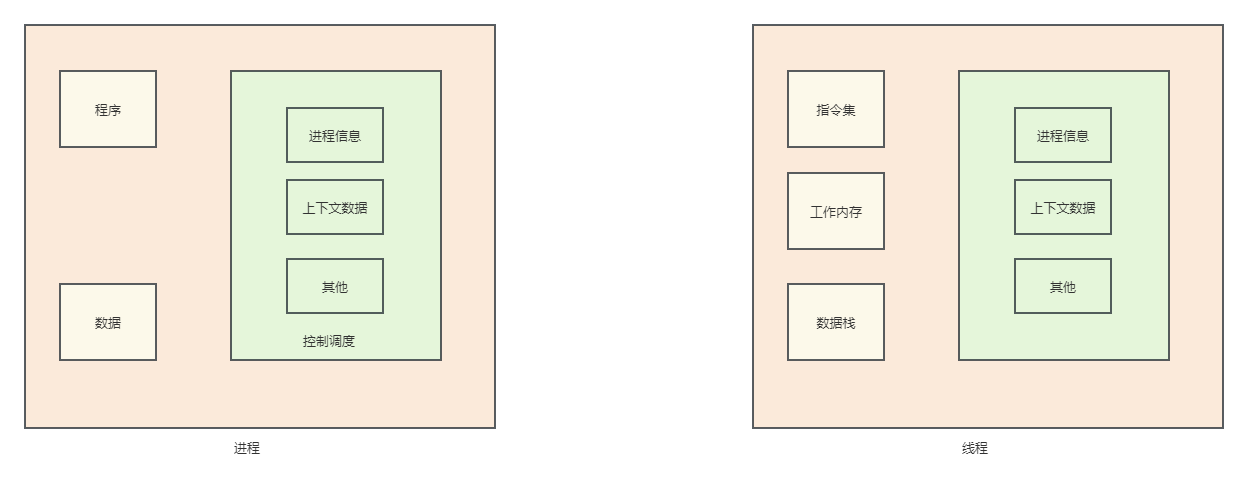
进程的概念不过多描述,但是对于java工程而言,每一个jvm启动一个java程序,就产生 一个jvm的进程。在这个jvm进程中,每一个任务都是由线程去完成的,所以进程是操作系统分配的最小单位,例如我在程序中运行了一个main()函数,那么main函数就是这个进程的主线程;而在中,包含了工作内存,它代表了进程中的一次顺序执行的过程,线程是由CPU调度的最小单元,并且在一个进程中,线程共享进程的内存数据。Java程序在JVM运行时就是一个最好的例子:当JVM将java编译成class文件后,就是开启了一个jvm的进程,然后在jvm的进程中开启线程执行。理论上来讲,开启一个jvm进程后,除了java线程外,还会开启GC线程。
同时,在线程中,线程的创建、销毁以及切换上下文的速率要比进程小的多,所以线程也称为轻量进程。
明确几个概念,方便下文理解:
上下文切换:CPU采用时间切片方式切换上下文,CPU可以给每一个进程分配一个时间段,如果时间结束进程仍在执行,那么就会阻塞当前的进程并将CPU分配给另一个进程,如果进程在时间结束前停止,那么就直接将CPU分配给另一个进程。换个意思就是说如果单核CPU,在宏观上观察执行了多个进程,可以理解为进程做到了并发执行,但是实际上任意时间只有一个进程会占用CPU。随着时间推移,我们不难发现这种条件并不能达到我们的要求,我们不能接口在某个时间内只有一个进程可以被执行,所以又有了线程。我们希望一个线程去执行一个任务,那么一个进程就可以执行多个任务。每个线程只需要执行它自己关心的任务即可。
但是一个进程往往在创建、销毁上代价巨大,而且进程间是相互独立的,无法做到通信,那么我们的线程可以在这种场景大派用场,它的过程是轻量的,而且在同一个进程下多个线程可以共享资源并相互通信。
-
线程的创建
java中,我们每创建一个线程,都对应着Thread的实例,在jvm调度时被使用,在同一时刻,一个CPU内核上只会存在一个Thread实例是正在被执行的,当前被执行的线程也叫做当前线程。
通过右侧图我们可以知道,其实不论是Runable还是Thrad都是通过FunctionalInterface去处理的。那么不同的继承链路代表了不同的特性。 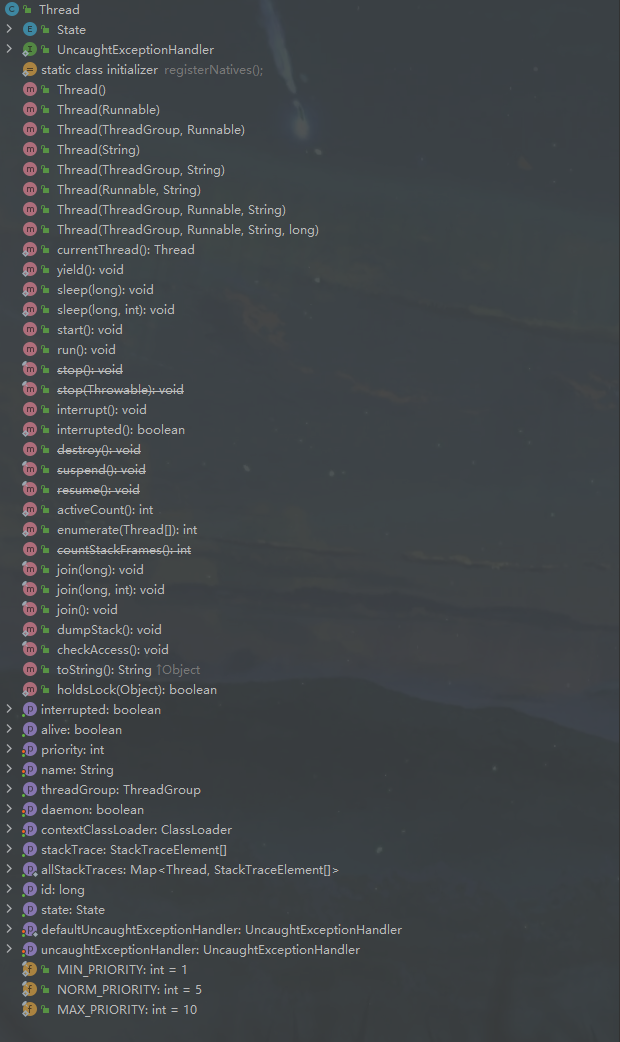
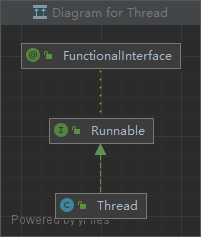 在Thread中,我们观察到几个重要的属性:
在Thread中,我们观察到几个重要的属性:
tid:代表当前线程id
volidate name:代表当前线程名称
priority:代表线程执行优先级(max = 10 min = 1 default = 5)
daemon:代表是否是守护线程,默认为false
group:线程所属的线程组
volidate threadStatus:线程的状态,默认为0
对于LockSupport、Object monitor 的介绍请参考之前的文章,这里不在过多描述
关于守护线程:守护线程是在进程运行时提供的后台服务的线程,常见的守护线程例如垃圾回收线程GC,我们甚至可以自定义守护线程,在线程初始化时默认为false,如果线程的父线程为守护线程,则默认当前也为守护线程
Thread parent = currentThread();
this.group = g;
this.daemon = parent.isDaemon();
这里截取部分代码段,完整请参考Thread#init()
注意:priority不能用作线程执行顺序的保证,线程执行顺序取决于是否获取CPU的切片,priority只是推荐尽量以优先级的顺序获取,但往往真实的情况出乎意料,所以如果我们要保证线程通信的顺序,建议后文中通过并发机制、锁、或线程间通信保证顺序
简单介绍下Thread其他的方法:
yield:本身是一个native方法,我们可以得知调用底层的cpp,当前方法是让当前线程让出CPU,不过要注意的是就算当前线程让出CPU,再调度时还可能再次获取到CPU。
sleep:底层调用native方法,睡眠。
join:阻塞的等待,底层调用wait方法,支持指定时间放弃等待。
interrupted:添加停止的标记量,无法立即将线程停止,只是将标记设置为停止。

1 public enum State { 2 /** 3 * 新建.并且没有执行前 4 */ 5 NEW, 6 7 /** 8 运行 9 */ 10 RUNNABLE, 11 12 /** 13 * 阻塞,并等待object监视器锁 14 */ 15 BLOCKED, 16 17 /** 18 * 等待,在调用Object.wait 、Thread.join、LockSupport.park后 19 */ 20 WAITING, 21 22 /** 23 * 计时结束,在调用Thread.sleep、LockSupport.parkNanos、LockSupport.parkUntil、Object.wait 、Thread.join 24 */ 25 TIMED_WAITING, 26 27 /** 28 * 结束、线程完成执行已终止 29 */ 30 TERMINATED; 31 }
在创建线程时,我们调用 synchronized void start()和 public void run()进行调用,需要注意的是,start后jvm会开启一个新的线程来执行自定义的代码,而run则是线程获取cpu后的入口代码,作为调用逻辑代码的入口。

1 public synchronized void start() { 2 /** 3 先判断是否是新建状态、否则抛出异常 4 */ 5 if (threadStatus != 0) 6 throw new IllegalThreadStateException(); 7 8 /* Notify the group that this thread is about to be started 9 * so that it can be added to the group's list of threads 10 * and the group's unstarted count can be decremented. */ 11 group.add(this); 12 13 boolean started = false; 14 try { 15 start0(); 16 /** 17 调用native方法 18 */ 19 started = true; 20 } finally { 21 try { 22 if (!started) { 23 group.threadStartFailed(this); 24 } 25 } catch (Throwable ignore) { 26 /* do nothing. If start0 threw a Throwable then 27 it will be passed up the call stack */ 28 } 29 } 30 } 31 32 @Override 33 public void run() { 34 if (target != null) { 35 target.run(); 36 } 37 }
我们知道jvm底层是由c++和部分机器语言编写的,在start0中,调用了native方法,其实在创建线程时,都会调用
/* Make sure registerNatives is the first thing <clinit> does. */ private static native void registerNatives(); static { registerNatives(); }
在c++中,会调用Java_lang_registerNative,在启动调用start0后,会调用dll中ThreadStart方法,创建Thread对象。这里感兴趣可以下载openJdk源码,在cpp中再切换到内核创建线程,然后再切换回用户态。可以去OpenJDK下载对应的hotSpot中jvm.cpp文件中查看。这里其实也说明了为什么我们在使用线程推荐使用线程池,防止因为每一次创建线程都会将用户态先切换到内核中创建thread,再切换回用户态中。
我们上文中说到,当前时间下只有CPU上执行的一个当前线程。获取当前线程可以通过 public static native Thread currentThread();静态方法获取。
创建线程,我们通常采用继承Thread或实现Runnable接口,除此之外,还有通过Callable接口或Future、FutureTask来实现创建线程。

1 public class MyThread extends Thread { 2 3 @Override 4 public void run() { 5 // 线程需要执行的任务 6 for (int i = 1; i <= 5; i++) { 7 System.out.println("This is MyThread extending Thread: " + i); 8 } 9 } 10 } 11 12 public class Main { 13 public static void main(String[] args) { 14 MyThread thread1 = new MyThread(); 15 thread1.start(); 16 17 MyThread thread2 = new MyThread(); 18 thread2.start(); 19 } 20 } 21 22 public class MyRunnable implements Runnable { 23 24 @Override 25 public void run() { 26 // 线程需要执行的任务 27 for (int i = 1; i <= 5; i++) { 28 System.out.println("This is MyRunnable implementing Runnable: " + i); 29 } 30 } 31 } 32 33 public class Main { 34 public static void main(String[] args) { 35 MyRunnable myRunnable1 = new MyRunnable(); 36 Thread thread1 = new Thread(myRunnable1); 37 thread1.start(); 38 39 MyRunnable myRunnable2 = new MyRunnable(); 40 Thread thread2 = new Thread(myRunnable2); 41 thread2.start(); 42 } 43 }
上面的例子我们通过Thread和Runable来创建了线程执行任务,但是我们根据上面继承得知底层都使用了Thread模型,这样这个任务无法收集到返回信息,因为它被void修饰,如果我们希望在线程执行完成之后获取返回值,就需要使用Callable、Future和FutureTask
1 @FunctionalInterface 2 public interface Callable<V> { 3 /** 4 * Computes a result, or throws an exception if unable to do so. 5 * 6 * @return computed result 7 * @throws Exception if unable to compute a result 8 */ 9 V call() throws Exception; 10 }
在juc中,我们可以看到Callable是支持泛型并且call带有返回值的。
同理,我们观察Future和FutureTask的结构,发现它们都是位于juc包下,juc是jdk给我们提供的并发组件包,通过继承关系可以得知Future和FutureTask的模型
首先,Future是一个泛型接口,定义了方法模板,而FutureTask则是Future的一个实现模型,它们都实现了Runable接口,但是它同时又实现了RunableFuture,一个自带泛型的返回,所以FutureTask就是基于Runable实现的带有泛型返回的task模型。
cancel:取消一个线程,但是并不一定能成功,如果已完成、已取消、或者因为其他原因无法取消,则尝试失败。传入 mayInterruptIfRunning 代表是否中断任务取消线程
get:阻塞,支持设置超时时间等待,注意:如果异步任务没有完成执行,那么它就会不停的等待下去,直到异步任务完成,我们可以设置时间来防止它无休止的等待下去,超过时间还没有完成后,会抛出异常。
isCancelled:是否被取消
isDone:是否完成
1 public interface Future<V> { 2 3 /** 4 * Attempts to cancel execution of this task. This attempt will 5 * fail if the task has already completed, has already been cancelled, 6 * or could not be cancelled for some other reason. If successful, 7 * and this task has not started when {@code cancel} is called, 8 * this task should never run. If the task has already started, 9 * then the {@code mayInterruptIfRunning} parameter determines 10 * whether the thread executing this task should be interrupted in 11 * an attempt to stop the task. 12 * 13 * <p>After this method returns, subsequent calls to {@link #isDone} will 14 * always return {@code true}. Subsequent calls to {@link #isCancelled} 15 * will always return {@code true} if this method returned {@code true}. 16 * 17 * @param mayInterruptIfRunning {@code true} if the thread executing this 18 * task should be interrupted; otherwise, in-progress tasks are allowed 19 * to complete 20 * @return {@code false} if the task could not be cancelled, 21 * typically because it has already completed normally; 22 * {@code true} otherwise 23 */ 24 boolean cancel(boolean mayInterruptIfRunning); 25 26 /** 27 * Returns {@code true} if this task was cancelled before it completed 28 * normally. 29 * 30 * @return {@code true} if this task was cancelled before it completed 31 */ 32 boolean isCancelled(); 33 34 /** 35 * Returns {@code true} if this task completed. 36 * 37 * Completion may be due to normal termination, an exception, or 38 * cancellation -- in all of these cases, this method will return 39 * {@code true}. 40 * 41 * @return {@code true} if this task completed 42 */ 43 boolean isDone(); 44 45 /** 46 * Waits if necessary for the computation to complete, and then 47 * retrieves its result. 48 * 49 * @return the computed result 50 * @throws CancellationException if the computation was cancelled 51 * @throws ExecutionException if the computation threw an 52 * exception 53 * @throws InterruptedException if the current thread was interrupted 54 * while waiting 55 */ 56 V get() throws InterruptedException, ExecutionException; 57 58 /** 59 * Waits if necessary for at most the given time for the computation 60 * to complete, and then retrieves its result, if available. 61 * 62 * @param timeout the maximum time to wait 63 * @param unit the time unit of the timeout argument 64 * @return the computed result 65 * @throws CancellationException if the computation was cancelled 66 * @throws ExecutionException if the computation threw an 67 * exception 68 * @throws InterruptedException if the current thread was interrupted 69 * while waiting 70 * @throws TimeoutException if the wait timed out 71 */ 72 V get(long timeout, TimeUnit unit) 73 throws InterruptedException, ExecutionException, TimeoutException; 74 }
在Future中,jdk其实帮我们定义了一套基于Future的规范,像FockJoin、Comtable等都采用了这种规范,为了方便起见,jdk又帮我们自行实现了一套标准化实现FutureTask,大多为了方便我们使用Exceutor执行submit时调用。
FutureTask中,实现了以下几种状态:
1 private volatile int state; 2 private static final int NEW = 0; 3 private static final int COMPLETING = 1; 4 private static final int NORMAL = 2; 5 private static final int EXCEPTIONAL = 3; 6 private static final int CANCELLED = 4; 7 private static final int INTERRUPTING = 5; 8 private static final int INTERRUPTED = 6;
其中,jdk指出,它们代表任务运行的状态,最初为new,也就是初始化完成后,在set、setException或cancel中,运行状态会发生变化,在完成时状态有可能为COMPLETING、INTERRUPTING,它们整体的变化路径为NEW -> COMPLETING -> NORMAL NEW -> COMPLETING -> EXCEPTIONAL NEW -> CANCELLED NEW -> INTERRUPTING -> INTERRUPTED。具体的实现这里不过多描述,大都是采用 sun.misc.Unsafe 和CAS过程完成。只是在返回是收集了Callable的泛型,并且用Compteion处理:
1 public void run() { 2 if (state != NEW || 3 !UNSAFE.compareAndSwapObject(this, runnerOffset, 4 null, Thread.currentThread())) 5 return; 6 try { 7 Callable<V> c = callable; 8 if (c != null && state == NEW) { 9 V result; 10 boolean ran; 11 try { 12 result = c.call(); 13 ran = true; 14 } catch (Throwable ex) { 15 result = null; 16 ran = false; 17 setException(ex); 18 } 19 if (ran) 20 set(result); 21 } 22 } finally { 23 // runner must be non-null until state is settled to 24 // prevent concurrent calls to run() 25 runner = null; 26 // state must be re-read after nulling runner to prevent 27 // leaked interrupts 28 int s = state; 29 if (s >= INTERRUPTING) 30 handlePossibleCancellationInterrupt(s); 31 } 32 }
可以看到获取到result后,指定了set(result),
protected void set(V v) { if (UNSAFE.compareAndSwapInt(this, stateOffset, NEW, COMPLETING)) { outcome = v; UNSAFE.putOrderedInt(this, stateOffset, NORMAL); // final state finishCompletion(); } }
通过CAS方式修改完成状态后,调用finishCompletion,如果出现异常,并且在中断前,就处理handlePossibleCancellationInterrupt
private void handlePossibleCancellationInterrupt(int s) { // It is possible for our interrupter to stall before getting a // chance to interrupt us. Let's spin-wait patiently. if (s == INTERRUPTING) while (state == INTERRUPTING) Thread.yield(); // wait out pending interrupt // assert state == INTERRUPTED; // We want to clear any interrupt we may have received from // cancel(true). However, it is permissible to use interrupts // as an independent mechanism for a task to communicate with // its caller, and there is no way to clear only the // cancellation interrupt. // // Thread.interrupted(); }
其实异常并没有做什么特别的,只是当线程状态为INTERRUPTING时,就尝试释放CPU,让其他线程去竞争CPU。
这里其实有一点很有意思的,在它们的根Runable接口上有一个@FunctionalInterface注解,熟悉lambda的朋友已经猜到我想说什么了...它是一个函数式编程注解,这里介绍以下函数接口
函数式接口,表明有且仅有一个抽象方法的接口,才能使用函数式接口注解@FunctionalInterface
所以,我们在使用时也可以这样写:
1 public class RunnableExample { 2 3 public static void main(String[] args) { 4 5 // 使用Lambda表达式创建Runnable对象 6 Runnable task = () -> { 7 // 任务内容 8 System.out.println("Executing task..."); 9 }; 10 11 // 创建线程并执行任务 12 Thread thread = new Thread(task); 13 thread.start(); 14 } 15 }
从上面的解析,我们可以判断出来,Runable的缺点为:
1.Runable依赖与传入的target,它才是真正执行的类,而Runable实现类并不是线程类,需要在构造器初始化创建线程
2。如果需要处理当前线程,不能直接通过Thread提供的方法,而需要Thread,currentThread()获取当前时间的线程进行处理
优点为:
1.首先Runable是一个接口,在JAVA单继承多实现体系下,能满足已经存在基类的需要
2.针对不同的逻辑处理、资源控制可以更清晰的划分边界。例如我有不同的处理handler,我只需要让每个handler指定对应的target,而不需要在逻辑中复杂的去处理它们的关系,这也满足了面向对象OOP的思想
3.我们使用ThreadPoolExecutor时,通过submit处理的是Runable的实现类
在介绍了FutureTask后,我们往往会有这样一种场景,主线程执行方法时,包含了某个或某多个耗时较长的动作,我不希望它们以串行的方式来执行,而是通过异步的方式执行并收集返回值,例如业务中有如下场景:
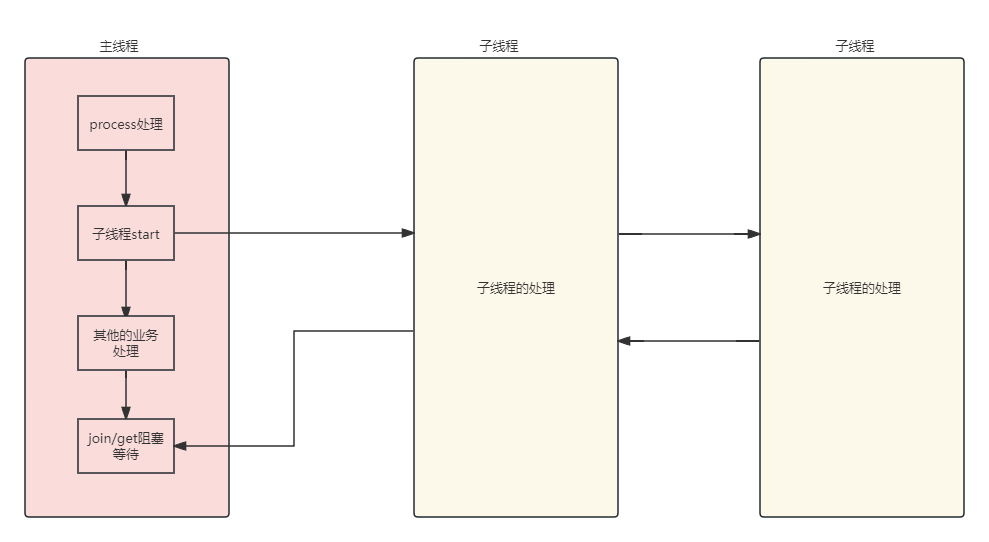
通过这种方式,我们不需要等待各种任务的处理,只需要在需要的时候等待异步线程的返回,并且收集返回结果。这种方法有两个弊端:
1.如果调用很频繁,需要自定义线程池,避免主线程全部阻塞导致主要业务停顿;
2.如果是基于第三方通信等动作,要考虑幂等性
3.当然,我们也可以通过ComptableFuture进行处理,它的原理其实就是Fock/Join框架的思想和Future的实现,具体的Fock/Join我们后文再详细讲解
当然,我们还有另一种方法,也是使用最多的方式:线程池
右侧继承关系得知,Executor接口,实现的有Executors,线程池工厂;ThreadPoolExecutor等等,为什么我们要选择线程池呢?
文章最开始描述了,进程的创建销毁耗费资源大,线程相对较小但是也会耗费资源。一个线程在完成后会被回收,意味着线程的生命周期就是上图介绍的状态流程,结束后会被回收。那么在高并发场景肯定不能频繁的创建和销毁线程池,我希望有一个可以复用的线程,它们在处理任务结束后不会被回收而是接着处理我其他的任务,这就是线程池最大的优势。
ExecutorService executorService = Executors.newFixedThreadPool(1);
这就是通过Executors工厂创建的单线程的线程池,线程数量只有1,使用线程池可以满足我们业务的情况下指定线程池的资源,再我们每次执行target任务时,将任务交给线程池去处理。注意:生产环境慎用Executors,为什么我们更加推荐ThreadPoolExecutor而不是Executors,其实主要是由于线程池队列模型决定的,比如常用的BlockQueue,DetlyQueue等等,Executors的队列基本是无界的,这会导致大量的task被强引用,无法gc会导致oom
在ExecutorService接口中,实现了Executor接口,那么就会有两个实现方法:submit和executor分别位于ExecutorService和Executor,我们在使用时它们的区别如下:
/** * Submits a value-returning task for execution and returns a * Future representing the pending results of the task. The * Future's {@code get} method will return the task's result upon * successful completion. * * <p> * If you would like to immediately block waiting * for a task, you can use constructions of the form * {@code result = exec.submit(aCallable).get();} * * <p>Note: The {@link Executors} class includes a set of methods * that can convert some other common closure-like objects, * for example, {@link java.security.PrivilegedAction} to * {@link Callable} form so they can be submitted. * * @param task the task to submit * @param <T> the type of the task's result * @return a Future representing pending completion of the task * @throws RejectedExecutionException if the task cannot be * scheduled for execution * @throws NullPointerException if the task is null */ <T> Future<T> submit(Callable<T> task); /** * Submits a Runnable task for execution and returns a Future * representing that task. The Future's {@code get} method will * return the given result upon successful completion. * * @param task the task to submit * @param result the result to return * @param <T> the type of the result * @return a Future representing pending completion of the task * @throws RejectedExecutionException if the task cannot be * scheduled for execution * @throws NullPointerException if the task is null */ <T> Future<T> submit(Runnable task, T result);
/** * Executes the given command at some time in the future. The command * may execute in a new thread, in a pooled thread, or in the calling * thread, at the discretion of the {@code Executor} implementation. * * @param command the runnable task * @throws RejectedExecutionException if this task cannot be * accepted for execution * @throws NullPointerException if command is null */ void execute(Runnable command);
可以看到 submit支持了Callable泛型和Runable泛型,代表着submit是支持返回值的,而execute只支持Runable。
-
线程的核心
上面我们介绍了线程的原理和创建线程的方式,上文中提到在java中创建线程其实调用的是底层cpp jcm.cpp,在jvm中,线程的调度依赖与CPU和操作系统,在hotsopt中jvm thread为不同的操作系统实现了多套规范,如Windows,Linux等等...那么我们在编写线程应用程序时,线程是如何进行运行的呢?
线程的运行依赖于CPU的时间切片,这个概念就是上文中说到的,如果单核cpu,它实现并发工作的思想是多个进程乃至线程轮番获得cpu的时间切片,然后占有cpu进行处理。从宏观上而言它们确实是并发的,但是从微观上来说当前时间只会有一个线程获取到cpu的资源。有点绕口,画个图:
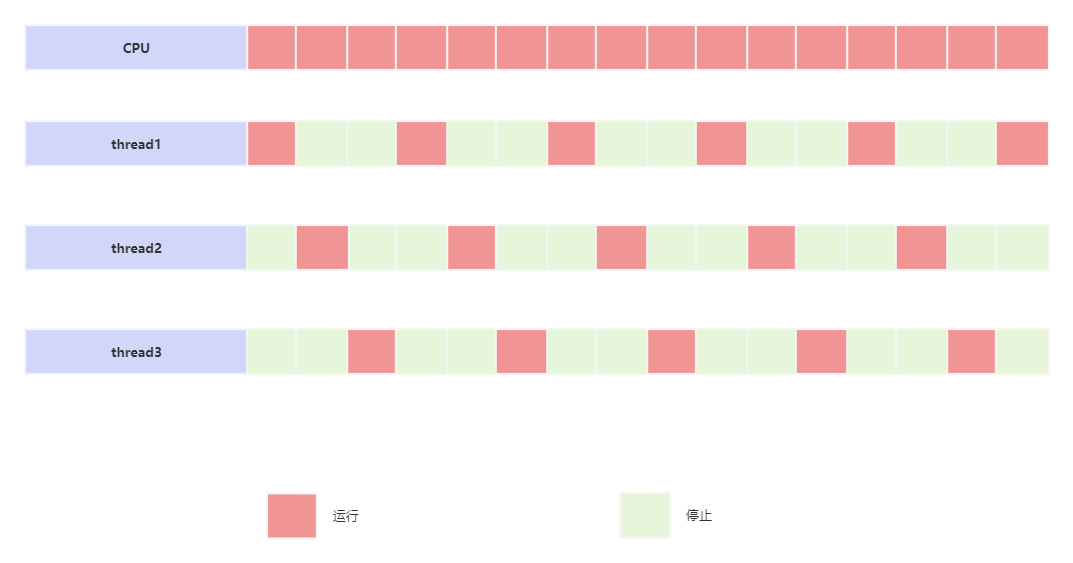
目前的操作系统调度线程的方式是:基于CPU时间切片进行调度,线程只有得到CPU时间切片才能获取资源执行,否则就等待分配。由于CPU的时间切片特别短,可以在各个线程直接切换,所以表现为宏观的并发执行,上图中所示分时调度,代表每个线程都是公平的,依次获取CPU的时间切片,依次调度执行;而还有一种方式是抢占CPU切片,这种方式才是目前大部分的模式,因为有次,对于线程来说本身也是有优先级。线程的优先级介绍在上文中。
线程的一次调度,就会贯穿线程的生命周期,在java中线程的生命周期为:(注意,这里说的是线程的生命周期状态,跟上文中FutureTask的state是不一样的)
public enum State { /** * Thread state for a thread which has not yet started. */ NEW, /** * Thread state for a runnable thread. A thread in the runnable * state is executing in the Java virtual machine but it may * be waiting for other resources from the operating system * such as processor. */ RUNNABLE, /** * Thread state for a thread blocked waiting for a monitor lock. * A thread in the blocked state is waiting for a monitor lock * to enter a synchronized block/method or * reenter a synchronized block/method after calling * {@link Object#wait() Object.wait}. */ BLOCKED, /** * Thread state for a waiting thread. * A thread is in the waiting state due to calling one of the * following methods: * <ul> * <li>{@link Object#wait() Object.wait} with no timeout</li> * <li>{@link #join() Thread.join} with no timeout</li> * <li>{@link LockSupport#park() LockSupport.park}</li> * </ul> * * <p>A thread in the waiting state is waiting for another thread to * perform a particular action. * * For example, a thread that has called <tt>Object.wait()</tt> * on an object is waiting for another thread to call * <tt>Object.notify()</tt> or <tt>Object.notifyAll()</tt> on * that object. A thread that has called <tt>Thread.join()</tt> * is waiting for a specified thread to terminate. */ WAITING, /** * Thread state for a waiting thread with a specified waiting time. * A thread is in the timed waiting state due to calling one of * the following methods with a specified positive waiting time: * <ul> * <li>{@link #sleep Thread.sleep}</li> * <li>{@link Object#wait(long) Object.wait} with timeout</li> * <li>{@link #join(long) Thread.join} with timeout</li> * <li>{@link LockSupport#parkNanos LockSupport.parkNanos}</li> * <li>{@link LockSupport#parkUntil LockSupport.parkUntil}</li> * </ul> */ TIMED_WAITING, /** * Thread state for a terminated thread. * The thread has completed execution. */ TERMINATED; }
NEW:新建,创建成功但是还没有被调用start
RUNABLE:Thread调用了start后如果线程获取到CPU的切片,开始执行。注意:调用start也许不会立刻被执行,而是需要获取到CPU的切片
BLOCKED:阻塞,例如被同步代码块或锁阻塞时
WAITING:这里的等待并不是等待CPU分配的切片,一个WAITING的线程不会被分配CPU切片,而是需要显式的被唤醒,否则就会一直处于等待状态。在后面篇幅中线程通信调度会详细说明
TIMED_WAITING:等待超时时间,在指定时间过后会自己唤醒,在未到达指定时间不会被CPU分配,在上面源码注释中也描述了几种处于TIMED_WAITING的状态
TERMINATED:在线程处于RUNABLE状态后,执行完成或者出现异常中断,线程将被终止,状态也会变为TERMINATED线程的操作
-
线程的操作
1. 线程的睡眠
public static native void sleep(long millis) throws InterruptedException; public static void sleep(long millis, int nanos) throws InterruptedException
线程的sleep方法,目的是让当前执行的线程休眠,让线程的执行状态变为阻塞状态,当时间结束后,线程也不是立刻进行工作,而是先将自己变成就绪状态,等待CPU的时间切片。
2. 线程的中断
java提供了stop方法用于结束线程,但是stop已经标记为弃用,@Deprecated,因为stop本身是一个很危险的方法。就像我们停止一个jvm进程,往往不会很粗暴的kill -9 因为在停止时,会有一系列的处理例如释放资源,回收,关闭连接。在程序中也一样,我们不推荐使用stop,因为它调用的cpp的stop,强制将一个线程停止,如果这个线程还持有某个锁,那这个锁将会永远无法被释放。那么一个线程如何停止?这里介绍Thread的interrupt方法,它在jdk源码中有一行注释:
// Just to set the interrupt flag
代表我们只是将interrupt的标记设置为停止,如果当前线程处于 wait(), wait(long), or wait(long, int) methods of the Object class, or of the join(), join(long), join(long, int), sleep(long), or sleep(long, int)阻塞状态,那么直接抛出InterruptedException.异常,线程处理异常退出;如果线程正在运行,那么不受影响继续运行,仅仅设置标记量,在适当的地方通过isInterrupted查看自己是否已经被中断,并执行响应的处理。

1 public class ThreadInterruptExample { 2 3 public static void main(String[] args) { 4 5 Thread thread = new Thread(() -> { 6 while (!Thread.currentThread().isInterrupted()) { 7 // 模拟执行任务 8 System.out.println("Executing task..."); 9 try { 10 Thread.sleep(1000); // 线程休眠1秒 11 } catch (InterruptedException e) { 12 // 捕获InterruptedException异常并处理 13 System.out.println("Thread interrupted, exiting..."); 14 Thread.currentThread().interrupt(); // 重新设置中断标志 15 } 16 } 17 }); 18 19 // 启动线程 20 thread.start(); 21 22 // 模拟主线程等待一段时间后中断子线程 23 try { 24 Thread.sleep(5000); // 等待5秒 25 } catch (InterruptedException e) { 26 e.printStackTrace(); 27 } 28 29 // 中断子线程 30 thread.interrupt(); 31 } 32 }
3. 线程的合并
合并比较抽象,用通俗的语言描述可以理解为:我有线程A和线程B,在某个时刻A需要等待B处理完成后再执行。

1 public class ThreadJoinExample { 2 3 public static void main(String[] args) { 4 5 Thread threadA = new Thread(() -> { 6 try { 7 System.out.println("Thread A is executing..."); 8 Thread.sleep(2000); // 模拟线程A执行任务的时间 9 System.out.println("Thread A completed."); 10 } catch (InterruptedException e) { 11 e.printStackTrace(); 12 } 13 }); 14 15 Thread threadB = new Thread(() -> { 16 try { 17 System.out.println("Thread B is executing..."); 18 Thread.sleep(3000); // 模拟线程B执行任务的时间 19 System.out.println("Thread B completed."); 20 } catch (InterruptedException e) { 21 e.printStackTrace(); 22 } 23 }); 24 25 // 启动线程A 26 threadA.start(); 27 28 // 等待线程A完成后,再启动线程B 29 try { 30 threadA.join(); 31 } catch (InterruptedException e) { 32 e.printStackTrace(); 33 } 34 threadB.start(); 35 } 36 }
4. 线程的放弃
yield方法,目的是让线程主动让出CPU切片,使其他线程可以获取到CPU,当前线程仍为RUNABLE状态,意味着它可以又一次获取到CPU的切片
5. 设置守护线程
守护线程最先让我们想到的是基于JVM的守护线程,例如JVM的GC线程,守护线程在用户线程存活时存活,当没有用户线程后结束。
设置守护线程,可以使用setDaemon为true,设置的线程下的子线程也会默认为守护线程,注意:比如在启动前设置,否则会抛出异常。
-
线程池
在上文创建线程的方式时,提到了线程池和EXECUTOR,目的是为了减少大量的线程创建销毁,而是交给线程池去异步调度,提升性能。
这里就会有一个很重要的问题?为什么线程池中的线程,或者说核心线程不会被回收?这个问题我们后面详细说明
线程池的存在,大大提升了执行异步任务时的性能,尤其在大量异步任务执行时,不需要再显式的创建线程,而是交给线程池去调度处理,这样有两点好处:
1.减少了频繁创建销毁线程带来的开销
2.线程池会对线程进行管理
-
Executor
Executor,及其衍圣类,是位于juc下线程池底层模型,它的继承关系比较简介。
首先,位于最上层抽象度最高的是Executor接口,它的核心只有一个就是 void execute(Runnable command);就是用来执行被提交的Runable
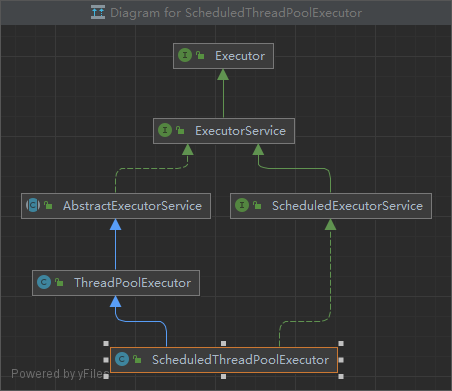
ExeccutorService实现了Executor,它提供了对任务的处理、提交。它是一个任务的接收者,它内部规范了
<T> Future<T> submit(Callable<T> task);
<T> Future<T> submit(Runnable task, T result);
<T> List<Future<T>> invokeAll(Collection<? extends Callable<T>> tasks) throws InterruptedException;
<T> T invokeAny(Collection<? extends Callable<T>> tasks) throws InterruptedException, ExecutionException;
用来提交Callable及Runnable的任务,支持单个提交或批量提交
AbstractExecutorService又实现了ExecutorService,作为一个抽象类,它定义了ExecutorService中默认的实现方式
ThreadPoolExecutor:赫赫有名的线程池工厂实现类,哪怕你没有看过juc的源码,我相信你从任何渠道都能了解到它。它继承了AbstractExecutorService,重写了部分默认Executor的规范,最显而易见的是,它定义了基于 RejectedExecutionHandler的拒绝策略:
AbortPolicy、CallerRunsPolicy、DiscardOldestPolicy、DiscardPolicy,并且它定义了基于Worker的模型,继承了 AbstractQueuedSynchronizer模型(大名鼎鼎的AQS)
ScheduledExecutorService:基于ExecutorService的实现,通过schedule、scheduleAtFixedRate等方法实现了周期和延时调度
ScheduledThreadPoolExecutor:实现了ScheduledExecutorService的机制
Executors:Executor的工厂,实现了快速创建ThreadPoolExecutor的工厂
Executors实现了几种快速创建线程池的方式,如:
1 public static ExecutorService newSingleThreadExecutor() { 2 return new FinalizableDelegatedExecutorService 3 (new ThreadPoolExecutor(1, 1, 4 0L, TimeUnit.MILLISECONDS, 5 new LinkedBlockingQueue<Runnable>())); 6 }
实现了创建单线程的线程池,创建的线程池只包含一个工作线程,执行任务采用FIFO的顺序执行,并且这个线程不会被回收,新来的多个任务会被阻塞在阻塞队列中,阻塞队列是无界的。
public static ExecutorService newFixedThreadPool(int nThreads) { return new ThreadPoolExecutor(nThreads, nThreads, 0L, TimeUnit.MILLISECONDS, new LinkedBlockingQueue<Runnable>()); }
实现了固定线程的线程池,nThreads为指定线程数,在执行任务时最大线程数量即为nThreads,所有线程繁忙后新增任务将会被阻塞在阻塞队列中,阻塞队列是无界的。
public static ExecutorService newCachedThreadPool() { return new ThreadPoolExecutor(0, Integer.MAX_VALUE, 60L, TimeUnit.SECONDS, new SynchronousQueue<Runnable>()); }
可缓存线程池,它的区别在于如果当前线程处于空闲状态时,会被线程池回收。通过参数可得这种线程池不会限制线程数量,而是交给jvm去处理,当新任务到来时,如果所有的线程已经繁忙,则会创建新的线程处理,如果线程空间则会被回收。
public static ScheduledExecutorService newScheduledThreadPool(int corePoolSize) { return new ScheduledThreadPoolExecutor(corePoolSize); }
延时调度线程池,它提供了延时处理的任务,它依赖
public ScheduledFuture<?> scheduleAtFixedRate(Runnable command, long initialDelay, long period, TimeUnit unit) { if (command == null || unit == null) throw new NullPointerException(); if (period <= 0) throw new IllegalArgumentException(); ScheduledFutureTask<Void> sft = new ScheduledFutureTask<Void>(command, null, triggerTime(initialDelay, unit), unit.toNanos(period)); RunnableScheduledFuture<Void> t = decorateTask(command, sft); sft.outerTask = t; delayedExecute(t); return t; } public ScheduledFuture<?> scheduleWithFixedDelay(Runnable command, long initialDelay, long delay, TimeUnit unit) { if (command == null || unit == null) throw new NullPointerException(); if (delay <= 0) throw new IllegalArgumentException(); ScheduledFutureTask<Void> sft = new ScheduledFutureTask<Void>(command, null, triggerTime(initialDelay, unit), unit.toNanos(-delay)); RunnableScheduledFuture<Void> t = decorateTask(command, sft); sft.outerTask = t; delayedExecute(t); return t; }
传入initialDelay:首次执行延时、period:间隔时间,当执行任务的时间大于间隔时间,会等待前一次调度完毕后继续用原有线程继续执行新任务。
在大多数情况下,我们尽量不适用Executors去创建线程池,而是通过ThreadPoolExecutor去创建线程池,在了解ThreadPoolExecutor后我们详细介绍为什么需要避免Executors的使用。
public ThreadPoolExecutor(int corePoolSize,
int maximumPoolSize,
long keepAliveTime,
TimeUnit unit,
BlockingQueue<Runnable> workQueue,
ThreadFactory threadFactory,
RejectedExecutionHandler handler) {
if (corePoolSize < 0 ||
maximumPoolSize <= 0 ||
maximumPoolSize < corePoolSize ||
keepAliveTime < 0)
throw new IllegalArgumentException();
if (workQueue == null || threadFactory == null || handler == null)
throw new NullPointerException();
this.acc = System.getSecurityManager() == null ?
null :
AccessController.getContext();
this.corePoolSize = corePoolSize;
this.maximumPoolSize = maximumPoolSize;
this.workQueue = workQueue;
this.keepAliveTime = unit.toNanos(keepAliveTime);
this.threadFactory = threadFactory;
this.handler = handler;
}
首先,观察ThreadPoolExecutor的构造函数,有几个比较重要的参数:
corePoolSize:核心线程数,这些线程在空闲也不会被回收
maximumPoolSize:最大线程数,执行任务线程数最大值
keepAliveTime:回收时间,非核心线程在空闲超过回收时间后会被回收
workQueue:任务队列的容器,常见的BlockQueue,DelayQueue等等...它们维护了任务队列的顺序,规则,特性
RejectedExecutionHandler :拒绝策略,往往我们会自定义拒绝策略
ThreadFactory:线程定义的一些其他信息,如ThreadGroup、ThreadName等等...
核心和最大线程数:当线程池收到新任务,并且工作线程少于核心线程数时,创建新线程,直到工作线程数已经达到了核心线程数;如果工作线程数已经大于核心线程数,但是小于最大线程数,那么只有任务队列已满时才会创建新线程,如果设置核心线程数和最大线程数相等,可以创建一个固定大小的线程池。
workQueue:最常用的时BlockQueue,如果接收到新任务核心线程都在繁忙状态,则将任务阻塞到BlockQueue中。
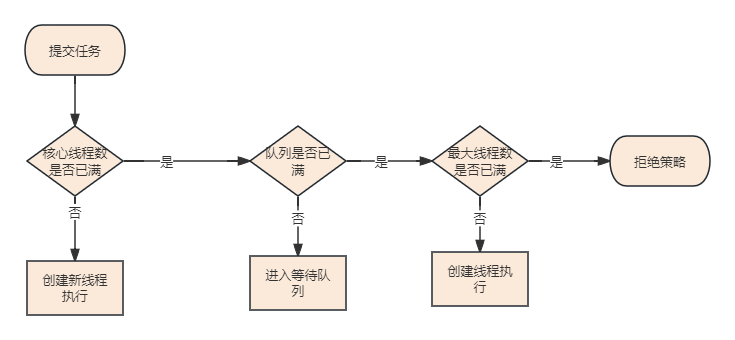
从上面的图中我们可以观察到,线程池工作的流程如下:
- 如果当前工作线程小于核心线程,那么创建一个线程执行
- 如果线程池中工作线程大于核心线程数量,新来的任务会进入队列等待,然后空闲的核心线程会再获取任务进行处理(线程复用)
- 如果核心线程已满,而且队列已经满了的情况下,会创建新线程执行任务直到工作线程数等于最大线程数
- 如果队列已经满了,而且线程总数也达到了最大线程数,再来新任务就会触发拒绝策略
那么线程池中的线程如何做到不被回收?我们说在观察源码时提到了Worker,是基于AQS完成的并发处理。其实在ThreadPoolExecutor中,它们会将工作线程包装成Worker节点,从Worker的源码中不难看出,Worker本身就是一个Runable线程,因为它实现了Runnable,那么我们主要关注它的run方法:
1 final void runWorker(Worker w) { 2 Thread wt = Thread.currentThread(); 3 Runnable task = w.firstTask; 4 w.firstTask = null; 5 w.unlock(); // allow interrupts //先释放掉锁 6 boolean completedAbruptly = true; 7 try { 8 while (task != null || (task = getTask()) != null) { //while一直获取task任务,如果获取到task则先给自己上一把锁,避免被中断 9 w.lock(); 10 // If pool is stopping, ensure thread is interrupted; 11 // if not, ensure thread is not interrupted. This 12 // requires a recheck in second case to deal with 13 // shutdownNow race while clearing interrupt 14 if ((runStateAtLeast(ctl.get(), STOP) || 15 (Thread.interrupted() && 16 runStateAtLeast(ctl.get(), STOP))) && 17 !wt.isInterrupted()) 18 wt.interrupt(); 19 try { 20 beforeExecute(wt, task); 21 Throwable thrown = null; 22 try { 23 task.run(); //再执行之际task 其实就是runable的target方法 24 } catch (RuntimeException x) { 25 thrown = x; throw x; 26 } catch (Error x) { 27 thrown = x; throw x; 28 } catch (Throwable x) { 29 thrown = x; throw new Error(x); 30 } finally { 31 afterExecute(task, thrown); 32 } 33 } finally { 34 task = null; 35 w.completedTasks++; 36 w.unlock(); 37 } 38 } 39 completedAbruptly = false; 40 } finally { 41 processWorkerExit(w, completedAbruptly); 42 } 43 }
1 private Runnable getTask() { 2 boolean timedOut = false; // Did the last poll() time out? 3 4 for (;;) { 5 int c = ctl.get(); 6 int rs = runStateOf(c); 7 8 // Check if queue empty only if necessary. 9 if (rs >= SHUTDOWN && (rs >= STOP || workQueue.isEmpty())) { 10 decrementWorkerCount(); 11 return null; 12 } 13 14 int wc = workerCountOf(c); 15 16 // Are workers subject to culling? 这一步其实是判断这个包装的线程是否是核心线程 如果不是核心线程那么线程池中总数是否大于核心线程数 17 boolean timed = allowCoreThreadTimeOut || wc > corePoolSize; 18 19 if ((wc > maximumPoolSize || (timed && timedOut)) //如果是核心线程 那么不走这里处理 不需要返回不被释放 20 && (wc > 1 || workQueue.isEmpty())) { 21 if (compareAndDecrementWorkerCount(c)) 22 return null; 23 continue; 24 } 25 26 try { 27 Runnable r = timed ? 28 workQueue.poll(keepAliveTime, TimeUnit.NANOSECONDS) : 29 workQueue.take(); 30 if (r != null) 31 return r; 32 timedOut = true; 33 } catch (InterruptedException retry) { 34 timedOut = false; 35 } 36 } 37 }
所以 对于线程池的核心线程,它们一直会被阻塞到workQueue.take private final BlockingQueue<Runnable> workQueue; workQueue是一个阻塞队列,它们永远会被阻塞直到线程池关闭或获取到task,因为上层一直再自自旋,对于非核心线程在经过处理后就会被回收掉返回。这就是线程池中线程为什么可以被复用的原因
在《JAVA高并发核心编程》中,有一个很有意思的错误案例,线程池配置不合理导致线程任务无法执行:
public static void main(String[] args) { ThreadPoolExecutor executor = new ThreadPoolExecutor( 1, 100, 100, TimeUnit.SECONDS, new LinkedBlockingQueue<>(100) ); for (int i = 0; i < 5; i++) { final int taskIndex = i; executor.execute(() -> { try { //极端测试 Thread.sleep(Long.MAX_VALUE); } catch (InterruptedException e) { throw new RuntimeException(e); } }); } while (true){ System.out.println("-activeCount:" + executor.getActiveCount() + "-taskCount:" + executor.getTaskCount()); sleepSeconds(1) } }
我们可以看到,创建线程池核心线程数1个 最大100个 队列最大100 添加五个任务并sleep 可是只会有一个任务在执行,剩余4个都在等待。就是因为一个任务占用核心线程,但是一直永远无法完成,阻塞队列没有满则不会创建非核心线程去执行剩下的四个任务。
在ThreadPoolExecuor中,我们观察源码得到信息:在将任务包装成Worker后,worker执行提供了钩子处理:
1 final void runWorker(Worker w) { 2 Thread wt = Thread.currentThread(); 3 Runnable task = w.firstTask; 4 w.firstTask = null; 5 w.unlock(); // allow interrupts 6 boolean completedAbruptly = true; 7 try { 8 while (task != null || (task = getTask()) != null) { 9 w.lock(); 10 if ((runStateAtLeast(ctl.get(), STOP) || 11 (Thread.interrupted() && 12 runStateAtLeast(ctl.get(), STOP))) && 13 !wt.isInterrupted()) 14 wt.interrupt(); 15 try { 16 beforeExecute(wt, task); ##前置钩子处理 17 Throwable thrown = null; 18 try { 19 task.run(); 20 } catch (RuntimeException x) { 21 thrown = x; throw x; 22 } catch (Error x) { 23 thrown = x; throw x; 24 } catch (Throwable x) { 25 thrown = x; throw new Error(x); 26 } finally { 27 afterExecute(task, thrown); ##后置钩子处理 28 } 29 } finally { 30 task = null; 31 w.completedTasks++; 32 w.unlock(); 33 } 34 } 35 completedAbruptly = false; 36 } finally { 37 processWorkerExit(w, completedAbruptly); 38 } 39 }
并且在退出时,提供了 terminated()调用,它也是一个钩子函数。
其中 beforeExecute、afterExecute 是在任务前后执行被调用,如果我们自定义的钩子方法在实现中抛出了异常,可能会导致工作线程异常停止。
-
拒绝策略
在上面线程池的运行流程中,我们不难发现在队列容器满了后会触发拒绝策略,因为我们使用ThraedPoolExecutor尽量避免采用无界的容器队列,所以拒绝策略就是帮助我们感知无法被提交的任务做补偿机制。在线程池中触发拒绝策略主要有以下两点:
1.队列满了并且最大线程已经到达极限
2.线程池被关闭了
在ThreadPoolExecutor中,线程池的拒绝策略主要是依赖与 RejectedExecutionHandler去实现的,在RejectedExecutionHandler只有一个方法处理:
void rejectedExecution(Runnable r, ThreadPoolExecutor executor);
在juc中,帮我们提供了几个默认的处理方式,主要有:
AbortPolicy:拒绝策略 直接拒绝并抛出 RejectedExecutionException异常(默认的)
DiscardPolicy:抛弃策略 什么都不干直接丢,很危险啊...
DiscardOldestPolicy:抛弃最老的 移除队列头部元素,先进的先滚蛋...
CallerRunsPolicy:调用者自己执行 线程池管不了你了,你自己玩把...更危险啊,使用不当会导致主线程都被阻塞掉
当然在spring中,也有自己的实现,具体参考spring framework源码。
在实际情况中,其实上面的几种方式都有不同的缺陷,为了更好的满足业务场景,我们往往会自定义拒绝策略,常见的方式例如延时添加(rocket源码参考可以发现在put message时如果触发拒绝策略那么就过一会儿再试试)、记录补偿redis、es等等用补偿队列去处理、或者发一个message等等...我们只需要实现RejectedExecutionHandler并初始化线程池时执行我们所需的handler去处理。
-
线程池的关闭
线程池的关闭,往往在我们使用中常常被忽略,我们往往在创建线程池使用后并不会去主动关闭它,更多的线程池是全局性线程池,但是在一些特定任务下,官方推荐手动关闭线程池。上文中我们介绍过,线程池在shutdown状态下,就不会接受新的任务了,只会处理现有的任务;线程池在stop状态下不会接受新的任务也不会处理剩余队列的任务;当所有任务处理完成,状态为tidying;执行完terminated()方法后,状态为terminated。
在juc中,给我们提供了几种关闭线程池的方式:
shutdown():是Executor提供的关闭方法,会将线程池设置为 SHUTDOWN状态,等待现有的任务执行完成,并且不会再接受新任务。
shutdownNow():立即关闭线程池,将线程池状态设置为 STOP,不接受新任务并且原有任务也也会被放弃并返回。
awaitTermination(long timeout, TimeUnit unit):等待线程池关闭。
来观察源码
1 public void shutdown() { 2 final ReentrantLock mainLock = this.mainLock; 3 mainLock.lock(); 4 try { 5 checkShutdownAccess(); //前置检查 6 advanceRunState(SHUTDOWN); //设置属性 7 interruptIdleWorkers(); //中断任务 8 onShutdown(); // hook for ScheduledThreadPoolExecutor 9 } finally { 10 mainLock.unlock(); 11 } 12 tryTerminate(); 13 } 14 15 private void interruptIdleWorkers(boolean onlyOne) { 16 final ReentrantLock mainLock = this.mainLock; 17 mainLock.lock(); 18 try { 19 for (Worker w : workers) { 20 Thread t = w.thread; 21 if (!t.isInterrupted() && w.tryLock()) { 22 try { 23 t.interrupt(); 24 } catch (SecurityException ignore) { 25 } finally { 26 w.unlock(); 27 } 28 } 29 if (onlyOne) 30 break; 31 } 32 } finally { 33 mainLock.unlock(); 34 } 35 }
1 public List<Runnable> shutdownNow() { 2 List<Runnable> tasks; 3 final ReentrantLock mainLock = this.mainLock; 4 mainLock.lock(); 5 try { 6 checkShutdownAccess(); 7 advanceRunState(STOP); 8 interruptWorkers(); 9 tasks = drainQueue(); 10 } finally { 11 mainLock.unlock(); 12 } 13 tryTerminate(); 14 return tasks; 15 } 16 private void interruptWorkers() { 17 final ReentrantLock mainLock = this.mainLock; 18 mainLock.lock(); 19 try { 20 for (Worker w : workers) 21 w.interruptIfStarted(); 22 } finally { 23 mainLock.unlock(); 24 } 25 } 26 void interruptIfStarted() { 27 Thread t; 28 if (getState() >= 0 && (t = thread) != null && !t.isInterrupted()) { 29 try { 30 t.interrupt(); 31 } catch (SecurityException ignore) { 32 } 33 } 34 }
首先对比上面的shutdown和shutdownNow我们可以发现,shutdown是设置状态避免接受新任务,然后中断空闲线程,等待所有的线程处理完成;而shutdownNow是设置状态后直接把所有的线程都停止,注意这里的停止其实不是让所有执行的线程立即结束,而是也通过标记量的方式告诉线程本身被停止,再合适的时机去结束线程。如何选择优雅的关闭线程池,在《java并发编程》中提到了,我们采用这种组合的方式关闭线程池,参考一下Dubbo中的某一个代码片段:
1 try { 2 if (threadPool.isTerminated()){ 3 for (int i = 0; i < 1000; i++) { 4 if (threadPool.awaitTermination(10, TimeUnit.MILLISECONDS)){ 5 break; 6 } 7 threadPool.shutdownNow(); 8 } 9 } 10 } catch (InterruptedException e) { 11 throw new RuntimeException(e); 12 }
awaitTermination方法不会立即返回,而是等待时间超过之后,如果关闭返回true,未关闭返回false,参考dubbo的代码可以实现一个线程池关闭的方法:
1 /** 2 * 实现ExecutorService的优雅关闭 3 * @param threadPool 4 */ 5 public static void shutdownThreadPool(ExecutorService threadPool){ 6 /** 7 * 已经关闭则不处理 8 */ 9 if (!(threadPool instanceof ExecutorService) || threadPool.isTerminated()){ 10 return; 11 } 12 /** 13 * 先停止接受新任务 14 */ 15 try { 16 threadPool.shutdown(); 17 } catch (SecurityException | NullPointerException e) { 18 /** 19 * 认证不通过或者threadPool已经为空 20 */ 21 return; 22 } 23 try { 24 /** 25 * 等待60秒关闭 26 */ 27 if (!threadPool.awaitTermination(60, TimeUnit.SECONDS)){ 28 /** 29 * 关闭线程池中的任务 30 */ 31 threadPool.shutdownNow(); 32 if (!threadPool.awaitTermination(60, TimeUnit.SECONDS)){ 33 //未正常结束 34 } 35 } 36 } catch (InterruptedException e) { 37 threadPool.shutdownNow(); 38 } 39 /** 40 * 如果还没关闭 那就再循环关闭 41 */ 42 try { 43 if (!threadPool.isTerminated()){ 44 for (int i = 0; i < 1000; i++) { 45 if (threadPool.awaitTermination(10, TimeUnit.MILLISECONDS)){ 46 break; 47 } 48 threadPool.shutdownNow(); 49 } 50 } 51 } catch (Throwable e) { 52 System.out.println(e.getMessage()); 53 } 54 }
-
线程池配置
在使用ThreadPoolExecutor时,最多的就是设置线程池线程数量了,不合理的配置会导致线程池运行状态出乎意料...类似上面那个错误配置的例子。线程池的线程数与异步任务的类型有很大的关系。在网上有很多介绍的例子,它们或多或少都有一定的区别。其实在任务上,主要我们可以将任务分为三类:
1.IO密集型
2.CPU密集型
3.混合型
IO密集型是指主要的任务处理IO操作,因为IO的操作时间较长并且大都是阻塞操作,它的特点是占用CPU较低,例如Netty的IO线程;CPU密集型主要是参与大量计算,响应较快,并且CPU占用较高,CPU在频繁的分片切换。由于IO密集型主要耗时在IO阻塞上,CPU占用不高,所以我们通常使用2 * CPU核心的线程数,CPU的核心数可以通过Runtime.getRuntime().availableProcessors()来获取;对于CPU密集型来说,我们直到线程的运行依赖CPU的切片。如果一个8核的CPU,有8个线程,理论上来说它们的性能是最高的,如果有80个线程,每个CPU就会根据这些线程来回调度分片,那么在切换上下文时就会有资源损耗,所以一般CPU密集型我们推荐线程数等于CPU的数量;对于混合型任务来讲,有这样一个公式:
(线程运行时间 / CPU等待时间) * (CPU数 + 1)
例如 一个任务耗时1000ms, CPU运行时间100ms 则线程数为: 10 * 5 = 50 (假设CPU数量为4),当然这种方式取决于具体的使用,不一定会准确,还有一种比较特殊的情况:某些系统在空闲时间会做归档做统计之类的任务,有些情况下可以将配置调大保证效率,但是并不是越大越好,具体需要参考压测的数据!(例如大名鼎鼎的redis,单线程多路复用性能也很强大,具体后文后我们再详细介绍为什么redis这么快?为什么它要采用多路复用?)
-
后记
本章主要介绍线程相关内容,在目录中介绍了本集合主要介绍的内容,下一章将会对jvm、锁、并发等内容详细介绍。
本文来自博客园,作者:青柠_fisher,转载请注明原文链接:https://www.cnblogs.com/oldEleven/p/17849987.html


